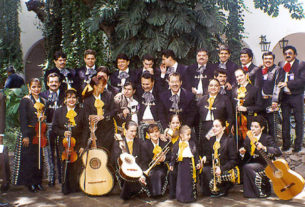It is entirely correct to think of the Aztec legend Quetzalcoatl in three contexts — as historical personality, as divinity and as literary subject. In the first incarnation he is a 10th century priest-king; in the second a deity associated with progress and humanity; in the third an object of intense interest to both ancient Aztec and more contemporary European scholars.
The historical Quetzalcoatl was probably born around AD 947. His father, Mixcoatl, was ruler of the Toltecs. He was originally named Ce Acatl Topitzin, meaning “Our Prince Born on Ce Acatl,” the latter being an important Toltec holiday. His birth was immediately preceded by a horrendous family tragedy, the father having been deposed and murdered by a jealous brother named Ihuitmal. The unborn child’s pregnant mother, Chimalma, fled to Tepoztlan. Before dying in childbirth, Chimalma declared that her infant son was divinely conceived because she had swallowed a piece of blue-green jade.
Reared by his grandparents, Ce Acatl Topitzin was sent to the religious school at Xochicalco. There he so impressed teachers with his wisdom and piety that they conferred on him the name of Quetzalcoatl. Meaning “plumed serpent,” this was a prestigious title given to persons whose behavior shows signs of an exalted state such as that attained by a saint or a sage. Returning to Tula, Quetzalcoatl defied his usurping uncle by burying the remains of his father with the ceremony to which he was entitled. He then took over as new leader of the Toltecs by pushing the unpopular Ihuitmal into a sacrificial fire.
Quetzalcoatl proved to be a wise and progressive ruler. In an action that demonstrated both sensitivity and enlightened self-interest, he imported a group of talented deaf-mutes known as nonoalcos to work as artisans in his kingdom. The nonoalcos were descendants of the highly skilled artisans of Teotihuacan and it was they who produced the distinctive designs for which Tula is noted — serpent columns, square pillars ornamented with friezes and giant-sized statues of warriors.
Quetzalcoatl also abolished human sacrifice and decreed that henceforth sacrificial objects be limited to snakes, flowers and small birds. It’s at this point that the line becomes blurred between the historical and the legendary Quetzalcoatl. Though the priests were undoubtedly annoyed by his outlawing of human sacrifice, accounts of the actions attributed to them are obviously the work of myth makers rather than of responsible historians. According to this version, the priests summoned an ancient god named Texcatlipoca to help them get rid of Quetzalcoatl. Texcatlipoca was an evil god, and he and the pro-human sacrifice priests obviously looked on Quetzalcoatl as some sort of bleeding-heart liberal. (The only bleeding hearts they wanted to see were the ones torn out of victims and laid on altars.)
Deciding on a ruse, Texcatlipoca crept into Quetzalcoatl’s sanctuary with two minor gods, also evil, and frightened him by demonstrating a new invention: the mirror. Feigning friendliness, they disguised him by covering his body with red paint, feathers and a mask. They served him a delicious meal and Texcatlipoca persuaded Quetzalcoatl to drink a beverage of pulque mixed with honey. The concoction made him drunk and the conspirators then slipped a beautiful dancing girl into his room. He awoke the next morning with a hangover and the horrible realization that he had broken his priestly vow of chastity.
Tormented with remorse, Quetzalcoatl wandered in self-imposed exile for twenty years and then ended up near what is today the Gulf port of Coatzocoalcos. There he said goodbye to a loyal band of weeping disciples, promising to return at some future time. He sailed for Yucatan, where he became equally admired by the Maya, who called him Kulkulcan. Finally, some thirty years later, he died by immolating himself on a self-made funeral pyre.
It’s at this point that legend gives way to literature. If Quetzalcoatl had a “literary agent,” at least as far as the West is concerned, he was a Franciscan friar named Bernardino de Sahagun. Sahagun, who came to Mexico in 1529, learned Nahuatl, the Aztec language, and became a teacher in the mission schools then being established for the sons of Mexican nobility.
For over fifty years Sahagun devoted himself to collecting data for a history of Mexico. He finished his vast work and sent it to the Council of the Indies in Madrid. There it gathered dust for two centuries until it was finally published in 1829 with the title Historia General de las Cosas de la Nueva Españia (“General History of the Things of New Spain.”)
Sahagun has been criticized for being more a collector of Aztec literature than an original and creative writer. Be that as it may, he rendered a valuable service by focusing on an inspiring poem called The Song of Quetzalcoatl. A court poem written by some ancient Aztec or Texcocan bard, it goes in part:
All the glory of the godhead
Had the prophet Quetzalcoatl:
All the honor of the people.
Sanctified his name and holy;
And their prayers they offered to him
In the days of ancient Tula.
Puzzling to some is how Quetzalcoatl apparently evolved into a white man. When Cortes’s small force landed in Mexico, the Aztecs could surely have crushed it by sheer weight of numbers. But Moctezuma II fatally hesitated: Quetzalcoatl, like Douglas MacArthur, had promised to return and it would be an act of extreme impiety to take arms against beings who might be revenants of their ancestral dieties. Yet how could the copper-skinned Meso-Americans possibly believe that these hairy, white-skinned invaders were in any way connected with them either on the human or divine level?
“The consensus of opinion among anthropologists,” writes Native American scholar Todd Downing, “is that Quetzalcoatl is the embodiment of a solar myth, hence his association with the east coast or the Atlantic. Yellow was the sacred color of the sun, so as its messenger he was given a beard like the rays of the sun.” This theory points up one of the cruelest ironies of the Conquest. Where most of the Spaniards were dark-haired Mediterranean types, one obviously descended from blond Visigoths was Cortes’s second in command, the fair-skinned, yellow-bearded Pedro de Alvarado. If the Aztecs saw Alvarado as an embodiment of their lost god, they selected the conquistador who was by far the most notorious for his cruelty toward Mexico’s Indian population.



